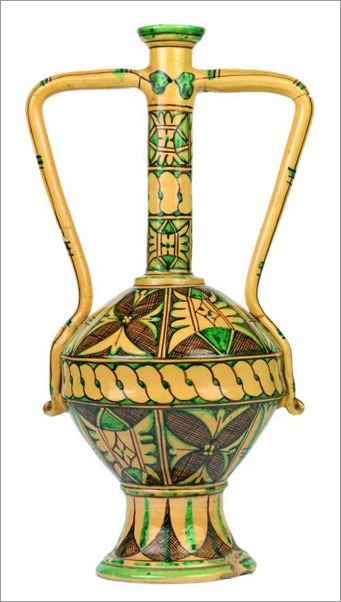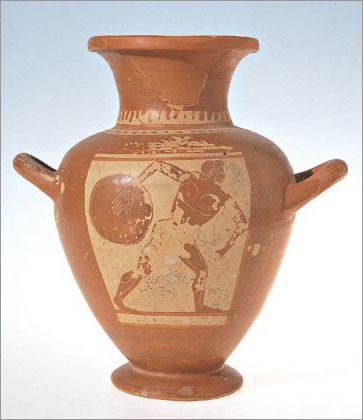November 8 – January 10, 2010
Perugia – Italy
 A very unusual art exhibition has opened in Perugia, that focuses on the birth of the movement of cultural property protection at the beginning of the 20th century against the massive acquisitions made by foreign Italian art collectors.
A very unusual art exhibition has opened in Perugia, that focuses on the birth of the movement of cultural property protection at the beginning of the 20th century against the massive acquisitions made by foreign Italian art collectors.
Art works, vintage pictures, original editions of books and documents tell the visitors the story of art collecting in the Western world and the effort of the Italian lawmakers in protecting our national heritage.
The symbol of the event is a 50 piece collection of Medieval ceramics made in Orvieto that was scattered across the world. For the first time in more than one hundred years they are under the same roof, the one of Palazzo Baldeschi in Perugia, Umbria.
 Around 1909 Italian art was a hot subject for European and American collectors. The pottery from Orvieto, specifically, grabbed the attention of John Pierpont Morgan, a notable collector of art objects, and Alexandre Imbert, an antique dealer.
Around 1909 Italian art was a hot subject for European and American collectors. The pottery from Orvieto, specifically, grabbed the attention of John Pierpont Morgan, a notable collector of art objects, and Alexandre Imbert, an antique dealer.
Imbert sponsored the research of a young archeologist from Orvieto and published it under the title “Orvieto Pottery from the 13th and 14th centuries”. The book was dedicated to JP Morgan and it has become a landmark textbook.
Although it was never made clear if he acted out of love for this art or out of sheer business instinct, Imbert was admittedly the first to discover and “advertise” the value and the beauty of the Medieval pottery from this region.
The collection that is temporarily on display in Perugia well summarizes the characteristics of Medieval ceramics from Orvieto. Very essential graphics and a limited color range – green and brown – were used on a large number of subjects: real or fantastic animals, kings and queens, mythological heroes, flowers and plants. Typically, some pieces are adorned by decorative attachments, or protomes, in the shape of busts of humans or animals, family crests, flowers.
Orvieto is now mostly famous for its Archaic pottery but the tradition of making clay vessels was actually born when the first inhabitants settled on the cliff dominating the Tiber valley in the south of Umbria. During the Etruscan age the local pottery production was varied and high quality. No matter which technique was used, the results were very often outstanding, especially when it came to polychrome architectural ceramics.
famous for its Archaic pottery but the tradition of making clay vessels was actually born when the first inhabitants settled on the cliff dominating the Tiber valley in the south of Umbria. During the Etruscan age the local pottery production was varied and high quality. No matter which technique was used, the results were very often outstanding, especially when it came to polychrome architectural ceramics.
A long tradition that came abruptly to an end at the beginning of the Renaissance, when other villages in Umbria – Deruta, Gubbio, Gualdo Tadino – became world famous for their exquisite artifacts.
But the “Orvieto style” was not dead. It influenced the first Renaissance pottery and inspired the research of some archeologists in the 19th century, who found the first kiln discards containing large quantities of shards that, sometimes, would fit into whole vessels. These ceramics often left Italy to find a good home in foreign Museums and collectors’ shelves.
Some of them are now back in their native region. It’s an event we can’t miss!
“1909, art collection and national heritage protection. John Pierpont Morgan, Alexandre Imbert and the Medieval pottery from Orvieto”.
Palazzo Baldeschi al Corso
Open Tue-Sun 9 am – 7 pm

Hello Jacqueline,
Galletto, aka Orvieto, aka Rooster dinnerware, originated in the 13th century in Orvieto, a charming medieval city in Umbria whose role in the rise and popularity of Italian pottery can hardly be overestimated.
Over the centuries, Orvieto passed the baton to Deruta as a major production center of fine ceramics. Galletto has been thriving in the good care of Deruta artisans, with new colors – red and blue – added to the original medieval green.
We carry a collection of Orvieto Roster here: https://www.thatsarte.com/collections/italian-tableware-kitchenware/galletto-verde.html
I have a small ceramic dish that has a signature on the bottom “Large Orvieto”. When I tried googling more information about it I became more interested in this piece. The item is hand painted and can be categorized as the “Green Rooster”. If you can offer me more information it would be greatly appreciated. Thank you in advance.
Such wonderful information. I have a few pieces that look very much like they might be from the same potter. Cups and saucer marked Ciarurro Orvieto.
Thank you for the info. I missed the exhibition for a few days while I was on vacation in Umbria and I was glad to find this post about it.
Patty